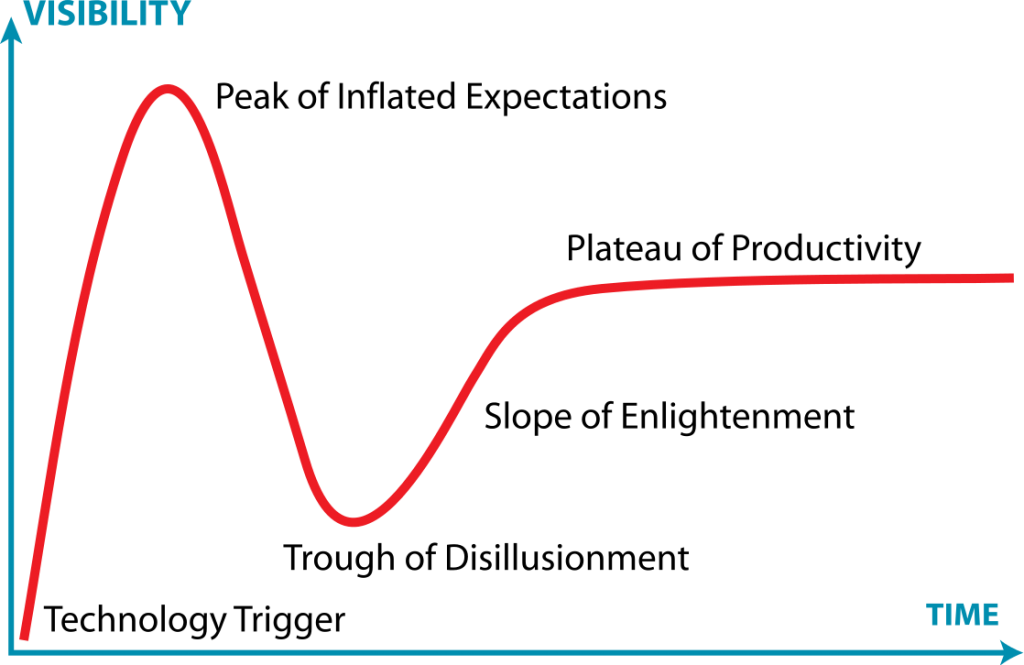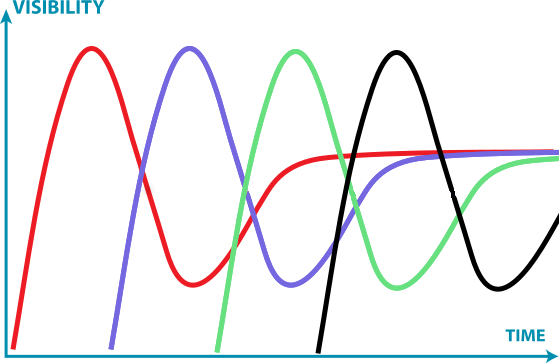Evergreen, Libraries and the Gartner Hype Cycle
- by admin
When PVNC first deployed our teacher laptops in 2006, Greg Reeves and I went to the board meeting and, for what I am sure was the first time ever, we asked the trustees to not approve the project. Do not approve this project, we said, if you are not prepared to continue it for the four years necessary to deploy to all our teachers. Do not approve this project if we cannot replace the laptops after four years, because once they have them, they will want to keep them. At the time I figured a laptop should last four years so that if we deployed to ¼ of our teachers each year we would keep our costs relatively stable and be well-positioned to renew the program in year 5. Back in those days we used to call this “evergreening” although evergreen seems to be taking on a new definition these days.
Our first year we decided to roll out laptops to our primary teachers, K-3. We struck a focus group and developed a professional development (PD) plan. We implemented software that would allow us to track the usage of the laptops and determine if they were being used. We discovered that we had a small cohort of teachers who, even after their two days of PD, were still not using their laptop. We worked with the school principals to bring these teachers in for an additional PD day. We got our count of reluctant users down to a single teacher, which for a cohort of 230, I thought was pretty good.
When we started our 21st Century Library project in 2012 we developed a similar plan. We were rolling out netbooks and iPads, both devices we expected would last four years. In picking ¼ of the schools we changed things up. We only took volunteers and selected volunteer schools where there was a willingness in school administration and the library to transform the library into a technology embedded hub. We wanted the “Coalition of the Willing.” We had volunteers until our fourth and final year when all we had was a group of schools that for whatever reason had delayed. Some of this was a “Let’s wait and see” approach…In a few cases I think there was hope that the digital transformation of the library was a fad that would surely blow over. Whatever the reason, we had a tool in our arsenal that we did not have when we did our teacher laptop project..a cohort of librarians who had all volunteered, who were keen and had been involved with the project for over three years. This secret weapon helped to save the day in that fourth year.
One of the charts I saw often in my MBA is Gartner’s Hype Cycle. It shows how consumer’s attitudes towards technology evolve over time, starting with adoption/introduction of the technology, called “the trigger” and ending with the “plateau of productivity.”

Take notice of the peak, the trough and the plateau. While I find the Hype cycle interesting, I think it gets very interesting (and helpful) when I layer four of them over one another and shift each by one year, in effect showing where each cohort of a four year rollout is on their journey with a new technology.

Things to note about my “evergreen” version:
When the year 1 cohort (red) is in their trough of disillusionment, the year 2 cohort (blue) is in their peak. The positive energy from the new cohort helps the previous cohort through the trough. This happens each year.
When you are in the fourth and final year you may not have the same excitement as you did with the early adopters but this is offset by the fact that your year 1 and 2 cohorts are now in their plateau of productivity. What we noticed in our library project is these early cohorts were excellent troubleshooters and were able to share their success stories to help along their colleagues who came later to the project.
In year 5, or the first refresh of the technology, you will have your first cohort in the peak, your 2nd and 3rd cohort in the productivity plateau, all available and willing to help your 4th cohort through the trough.
An obvious drawback to this strategy is that it takes four years to fully implement but my experience has been that for large system level change it is best to go this slow. It stabilizes cost, allows for the organisation to adapt and gives time for new capabilities to be embedded in the culture. In conclusion, evergreen+hype cycle=success.
Originally posted June 26, 2017 to meet a course requirement for my MBA. Revised and republished 29 December 2021.
When PVNC first deployed our teacher laptops in 2006, Greg Reeves and I went to the board meeting and, for what I am sure was the first time ever, we asked the trustees to not approve the project. Do not approve this project, we said, if you are not prepared to continue it for the…